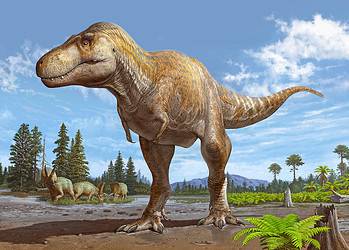The famously tiny arms of Tyrannosaurus rex may have become so diminutive to protect the predator from accidental — or even intentional — amputations during feeding frenzies.

Ask people in the street to name one fearsome dinosaur, and chances are “T-rex” will be mentioned a lot. Still, this ‘king of the dinosaurs‘ (rex means ‘king’ in Latin) had one less-than distinguished feature: its ridiculously-short arms. Researchers, as well as students, pupils, or simple dinosaur aficionados, wonder, at one point or another, just why this massive dinosaur sported arms so short. A new study attempts to answer just that.
According to the findings, T. rex might have evolved to have short arms for workplace health and safety.
Short for a cause
“What if several adult tyrannosaurs converged on a carcass? You have a bunch of massive skulls, with incredibly powerful jaws and teeth, ripping and chomping down flesh and bone right next to you. What if your friend there thinks you’re getting a little too close? They might warn you away by severing your arm,” said lead author Kevin Padian, distinguished emeritus professor of integrative biology at the University of California, Berkeley, and a curator at the UC Museum of Paleontology (UCMP).
“So, it could be a benefit to reduce the forelimbs, since you’re not using them in predation anyway.”
There is no shortage of hypotheses on why T. rex’s arms were so short; these cover everything from mating to grabbing prey or some other predatory role. But not one of these ideas has managed to impose itself over the others, or gather particularly large amounts of support. Padian believes that researchers have been attacking the issue wrong until now. Instead of asking what purpose the dinosaur’s short arms evolved to accomplish, we should instead think what benefit these arms were for the animal.
His hypothesis is that T. rex‘s arms became so small to prevent accidental or intentional amputation during the feeding frenzy of a pack of these dinosaurs. Severe wounds — such as the loss of a limb to an over-eager or aggressive packmate — can lead to life-threatening complications including hemorrhaging, shock, or infection, Padian explains.
He adds that the ancestors of tyrannosaurs had longer arms, suggesting that the transition towards shorter limbs with less joint mobility and strength served a purpose, otherwise the trade-off wouldn’t have given the animals an evolutionary advantage. For context, a 45-foot-long (13.7 meters) T. rex would have a 5-foot-long (1.5 meters) skull but arms of only 3 feet (0.9 meters) in length, which is equivalent to a 6-foot (1.8 meters) tall human having 5-inch (12.7 cm) arms.
This shift would have affected both T. rex, which lived in North America at the end of the Cretaceous, as well as their related species of abelisaurids and carcharodontosaurids, which ranged across South America and Eurasia, respectively, in the Early and Mid-Cretaceous.
“All of the ideas that have been put forward about this are either untested or impossible because they can’t work,” Padian said. “And none of the hypotheses explain why the arms would get smaller—the best they could do is explain why they would maintain the small size. And in every case, all of the proposed functions would have been much more effective if the arms had not been reduced.”
Padian admits that his hypothesis, as well as any others on this topic, would be hard to prove so long after the dinosaurs went extinct. Still, based on recent theories that T. rex‘s hunted in packs, the hypothesis he puts forward does seem to have some merit.
“Several important quarry sites unearthed in the past 20 years preserve adult and juvenile tyrannosaurs together,” he said. “We can’t really assume that they lived together or even died together. We only know that they were buried together. But when you find several sites with the same animals, that’s a stronger signal. And the possibility, which other researchers have already raised, is that they were hunting in groups.”
Padian’s hypothesis does seem to have some analogues today. He cites the giant Komodo Dragon lizards (Varanus komodoensis) of Indonesia, which hunt in groups. Larger individuals descend on the carcass after a hunt, leaving only modest remains for the younger, smaller dragons. Crocodiles can also cause severe injuries to one another during feeding.
One element which could help push the hypothesis forward is to check T. rex fossils from museums around the world for bite marks on their front limbs. That being said, a very low percentage of specimens from a species ever fossilize, so we might be looking for a needle in a haystack.
“Bite wounds on the skull and other parts of the skeleton are well known in tyrannosaurs and other carnivorous dinosaurs,” he said. “If fewer bite marks were found on the reduced limbs, it could be a sign that reduction worked.”
“What I first wanted to do was to establish that the prevailing functional ideas simply don’t work. That gets us back to square one. Then, we can take an integrative approach, thinking about social organization, feeding behavior and ecological factors apart from purely mechanical considerations.”
The paper “Why tyrannosaur forelimbs were so short: an integrative hypothesis” has been published in the journal Acta Palaeontologica Polonica.






